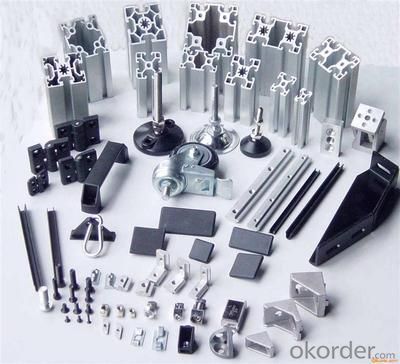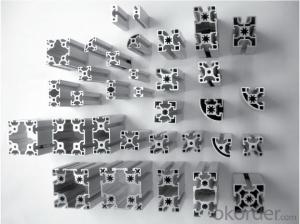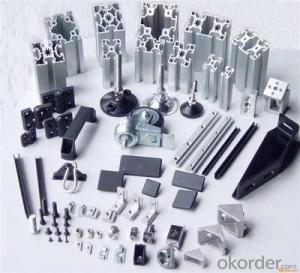Shower Room OEM Aluminum Extrusion for high voltage Switchgear
- Loading Port:
- Guangzhou
- Payment Terms:
- TT OR LC
- Min Order Qty:
- 5 m.t.
- Supply Capability:
- 1000 m.t./month
OKorder Service Pledge
OKorder Financial Service
You Might Also Like
Item specifice
1.Structure of Shower Room OEM Aluminum Extrusion for high voltage Switchgear Description:
Anodizing (also spelled anodising, particularly in the UK and Australia) is an electrolytic passivation process used to increase the thickness of the natural oxide layer on the surface of metal parts. Anodized aluminium surfaces, for example, are harder than aluminium but have low to moderate wear resistance that can be improved with increasing thickness or by applying suitable sealing substances.
2.Main Features of the Shower Room OEM Aluminum Extrusion for high voltage Switchgear:
High corrosion-resistance;
weather-resistance;
heat-resistance;
alkali-resistance and impact-resistance properties.
3.Shower Room OEM Aluminum Extrusion for high voltage Switchgear Images:



4.Aluminium Profile for Cars Auto-parts Good Quality Specification:
1. Material: 6063,6061,6060,6005,6005A,etc.
2. Temper: T5 or T6
3. Finish: Mill finish, anodizing, powder coating, electrophoresis, wooden transfer or pvdf/carbon-flouride coated, polishing, brushing, sand blasting
4. Various colors: Silver, bronze, black, gold, blue, grey, champagne, bright, etc.
5. Machining: Cutting, punching, drilling, tapping, milling, bending, welding, CNC etc.
5.FAQ:
①How about your company?
A world class manufacturer & supplier of castings forging in carbon steel and alloy steel,is one of the large-scale professional investment casting production bases in China, consisting of both casting foundry forging and machining factory. Annually more than 8000 tons Precision casting and forging parts are exported to markets in Europe, America and Japan. OEM casting and forging service available according to customer’s requirements.
②How to guarantee the quality of the products?
We have established the international advanced quality management system,every link from raw material to final product we have strict quality test;We resolutely put an end to unqualified products flowing into the market. At the same time, we will provide necessary follow-up service assurance.
- Q:Everybody good: please look at this section of the aluminum can not buy ready-made standard parts. If the mold needs to be opened, is it the extrusion process? About how much is the die charge?. Thank you.
- Can do, large amount of words, mold costs borne by the manufacturers. Maybe two dies.
- Q:How do aluminum profiles contribute to water management strategies?
- Aluminum profiles contribute to water management strategies by being used in the construction of water tanks, pipes, and fittings. These profiles have excellent corrosion resistance and durability, making them ideal for storing and transporting water. Additionally, their lightweight nature allows for easy installation and maintenance. Overall, aluminum profiles play a crucial role in ensuring efficient water management systems by providing reliable and long-lasting infrastructure.
- Q:How do you prevent warping or distortion of aluminum profiles during fabrication?
- To prevent warping or distortion of aluminum profiles during fabrication, several measures can be taken. Firstly, it is important to ensure that the profiles are properly stored and handled before fabrication, avoiding any bending or twisting. During the fabrication process, maintaining consistent and controlled heat is crucial. This can be achieved through proper temperature regulation and using appropriate welding techniques. Additionally, employing fixtures or jigs to hold the profiles in place during fabrication can minimize any potential warping. Lastly, allowing sufficient cooling time after welding or machining processes can help alleviate any residual stress that may lead to warping.
- Q:Surface treatment method of aluminium profile
- Five most common surface treatment methods for aluminum profilesFabric: Aluminum matte matte surface aluminum profile Aluminum Alloy to avoid the presence of light interference will form light environment, under the condition of building decoration in the shortcomings of its surface such as brocade as soft and delicate, very popular with the favor of the market, but the existing grinding material must overcome the uneven surface of the sand, and can see the lack of pattern.Multi color surface treatment of aluminum: the monotonous white and tinted silver has been unable to meet the good cooperation of architects and the exterior decorative tile, exterior wall latex, new stainless steel color, champagne, gold, gold, titanium series (red wine, red jujube red, black, purple etc.) plus color glass the decorative effect of the icing on the cake. These shapes must be chemically or mechanically polished and then oxidized to better effect.Electrocoating aluminium profiles: electrophoretic coating profiles of surface soft luster, can resist the erosion of acid rain, cement mortar, Japan 90% aluminum after electrophoretic coating.Powder electrostatic spraying aluminum profile: powder electrostatic spraying profile is characterized by excellent corrosion resistance, acid, alkali, salt fog is much better than oxidation coloring section.Plasma enhanced electrochemical surface ceramic aluminum profile: this type of material is the most advanced processing technology in the world today. The profile products are of good quality, but the cost is higher. It has more than 20 kinds of colors, the biggest feature is that it can be printed as needed according to the printing cloth, the surface of the section is colourful and the decoration effect is excellent.
- Q:Can aluminum profiles be used in modular construction?
- Yes, aluminum profiles can be used in modular construction. Aluminum is a lightweight and durable material that is often utilized in modular construction due to its strength, corrosion resistance, and ease of customization. It is commonly used in the production of modular frames, panels, and components, offering flexibility in design and assembly. Additionally, aluminum profiles can be easily recycled, making them an environmentally friendly choice for modular construction projects.
- Q:Can aluminum profiles be used in window and door manufacturing?
- Yes, aluminum profiles can be used in window and door manufacturing. Aluminum is a popular choice for window and door frames due to its durability, strength, and corrosion resistance. It provides excellent structural integrity while allowing for sleek and modern designs. Additionally, aluminum profiles can be easily customized and come in a variety of finishes, making them a versatile option for window and door manufacturers.
- Q:Can aluminum profiles be used in the production of laboratory equipment?
- Yes, aluminum profiles can be used in the production of laboratory equipment. Aluminum is a versatile and widely used material in various industries, including laboratory equipment manufacturing. Aluminum profiles offer several advantages for laboratory equipment production. Firstly, aluminum is lightweight yet strong, making it ideal for constructing equipment that needs to be portable or moved frequently within the laboratory. Its lightweight nature also reduces the strain on laboratory personnel when handling and transporting the equipment. Secondly, aluminum profiles can be easily shaped and molded into various forms and sizes, allowing for the customization of laboratory equipment to meet specific requirements. This flexibility in design enables the production of equipment with complex shapes and structures, ensuring optimal functionality and efficiency. Additionally, aluminum is corrosion-resistant, which is crucial in laboratory settings where exposure to chemicals and liquids is common. This property helps to extend the lifespan of the equipment and ensures it remains in good condition even after prolonged use. Furthermore, aluminum profiles can be anodized or coated to provide additional protection against wear, scratches, and other types of damage. This makes the equipment more durable and easier to clean, maintaining the required hygiene standards in laboratories. Lastly, aluminum is a highly conductive material, making it suitable for applications that require heat transfer or electrical conductivity. This property is advantageous for laboratory equipment such as heating plates, heat sinks, or electrical circuit components. In conclusion, aluminum profiles can indeed be used in the production of laboratory equipment. Their lightweight, malleable, corrosion-resistant, and conductive properties make them a suitable choice for manufacturing various types of laboratory equipment, ensuring durability, functionality, and ease of use.
- Q:What are the different bending and forming options for aluminum profiles?
- There are several bending and forming options available for aluminum profiles, each with its own advantages and applications. Some of the common methods include: 1. Cold bending: This is a widely used process that involves bending the aluminum profile using external force without the use of heat. Cold bending can be done manually or with the help of machinery such as press brakes or rollers. It is suitable for creating simple shapes and can be cost-effective for low volume production. 2. Heat bending: In this method, the aluminum profile is heated to a specific temperature, which makes it more malleable and easier to bend. Heat bending is often used for complex or precise shapes that cannot be achieved through cold bending. It requires specialized equipment, such as heating lamps or furnaces, and skilled operators to ensure accurate results. 3. Roll forming: This process involves passing the aluminum profile through a series of rollers to gradually shape it into the desired form. Roll forming is suitable for creating continuous shapes or long lengths of profiles with consistent dimensions. It is commonly used in industries such as construction, automotive, and furniture manufacturing. 4. Stretch forming: Stretch forming is a method that involves clamping the aluminum profile at its edges and stretching it over a form or mold. This process allows for the creation of complex curves and contours, making it ideal for applications that require intricate designs or unique shapes. Stretch forming is commonly used in aerospace, architectural, and automotive industries. 5. Hydroforming: Hydroforming uses pressurized fluid to shape the aluminum profile into a mold. The fluid pressure forces the metal to conform to the shape of the mold, resulting in precise and high-quality formed parts. Hydroforming is particularly advantageous for creating lightweight and structurally efficient components, making it popular in the automotive and aerospace industries. These bending and forming options provide a range of possibilities for shaping aluminum profiles to meet specific design requirements. The choice of method depends on factors such as the complexity of the desired shape, production volume, cost considerations, and the specific industry application.
- Q:The 50 series and the 60 series of aluminum profiles, which one is good?
- Of course, 60 of the good.60 and 50 refers to profiles, from the indoor to outdoor overall thickness of 60MM and 50MM. respectively60 of the cross section is larger than 50 1cm, much stronger. The glass gap that can be installed is also larger
- Q:Can aluminum profiles be used in the construction of modular buildings?
- Modular buildings can benefit from the utilization of aluminum profiles. These profiles possess a combination of lightweight properties and strength, ensuring durability and making them a perfect material for modular construction. Their fabrication and joining processes are straightforward, enabling flexibility in both design and construction. Furthermore, aluminum profiles showcase exceptional resistance to corrosion, a vital characteristic for modular buildings that might face diverse weather conditions. Moreover, the employment of aluminum profiles in modular construction can contribute significantly to sustainability since aluminum is highly recyclable. Due to these advantages, aluminum profiles have become a favored choice in the industry for constructing modular buildings.
1. Manufacturer Overview |
|
|---|---|
| Location | |
| Year Established | |
| Annual Output Value | |
| Main Markets | |
| Company Certifications | |
2. Manufacturer Certificates |
|
|---|---|
| a) Certification Name | |
| Range | |
| Reference | |
| Validity Period | |
3. Manufacturer Capability |
|
|---|---|
| a)Trade Capacity | |
| Nearest Port | |
| Export Percentage | |
| No.of Employees in Trade Department | |
| Language Spoken: | |
| b)Factory Information | |
| Factory Size: | |
| No. of Production Lines | |
| Contract Manufacturing | |
| Product Price Range | |
Send your message to us
Shower Room OEM Aluminum Extrusion for high voltage Switchgear
- Loading Port:
- Guangzhou
- Payment Terms:
- TT OR LC
- Min Order Qty:
- 5 m.t.
- Supply Capability:
- 1000 m.t./month
OKorder Service Pledge
OKorder Financial Service
Similar products
New products
Hot products
Related keywords





























